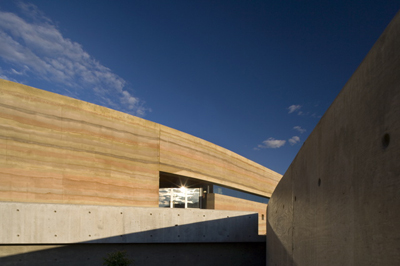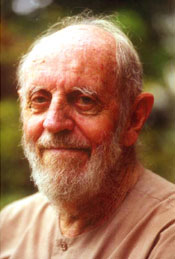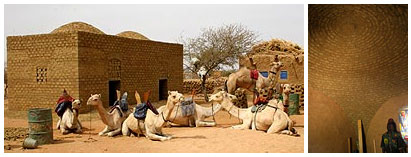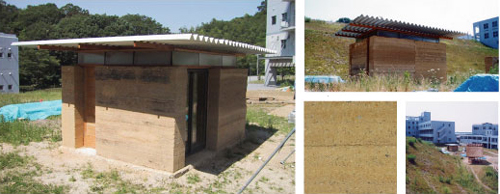An interesting building material production technique is outlined in a recent article by the BBC which suggests a Russian technique for manufacturing building blocks out of sand and seawater. The article also notes that unfired mud brick (adobe) technology has taken off in the US, dispensing with the energy used in firing traditional clay bricks.
5º Seminário de Arquitectura de Terra em Portugal
A UA / Universidade de Aveiro, a ESG / Escola Superior Gallaecia, a FCO / Fundação Convento da Orada e a Cdt / Associação Centro da Terra são os organizadores e anfitriões do 5º Seminário de Arquitectura de Terra em Portugal (V ATP), que se realizará de 10 a 13 de Outubro 2007, na Universidade de Aveiro, em Portugal. Criado em 2003, o seminário Arquitectura de Terra em Portugal tem evoluído de uma forma crescente com a ampla adesão de profissionais ibero-americanos e europeus.
Nk’Mip Desert Cultural Centre

Nk’Mip Desert Cultural Centre by Hotson Bakker Boniface Haden Architects was recently completed and featured in the April issue of Canadian Architect Magazine. The cultural center is constructed of the largest rammed earth wall in North America measuring 80 metres (262 feet) long by 5.5 metres (18 feet) high made of layers of colored stabilized soil.
Laurie Baker, 1917-2007

Lawrence Wilfred “Laurie” Baker (March 2, 1917 – April 1, 2007) was an award-winning English architect, renowned for his initiatives in low-cost housing by using traditional techniques, materials and crafts such as mud and thatch. He went to India in 1945 in part as a missionary and since then lived and worked in India for over 50 years. He obtained Indian citizenship in 1989 and resided in Thiruvananthapuram (Trivandrum), Kerala. In 1990, the Government of India awarded him with the Padma Shri, the nation’s fourth highest civilian award, in recognition of his meritorious service in the field of architecture.
“You can’t get more sustainable or renewable a resource than mud, and Baker is its champion. Approximately 58 percent of all buildings in India today are made of mud brick, some as many as 50 to 100 years old. Mud is gathered either at the construction site or very nearby, formed into bricks and dried in the sun. It is readily available and can be made by people with limited initial training—all resulting in projects that can be built at a fraction of the cost of those using concrete and steel. Baker is especially fond of mud’s total recycle-ability: simply add water and reuse it.”
– Farewell Laurie Baker
Links: Of Mud and Men: Architecture as a Political Act | Of Architectural Truths and Lies | Laurie Baker’s Creative Journey | Mud: Laurie Baker
Woodless Construction

Woodless construction is an approach to building in the sahel that uses traditional building techniques to build houses entirely out of mud, including the roof. Such houses save on scarce wood, encourage local industry by using local skills and materials, and provide good internal comfort, staying warm in cold season, and cool in hot season.
Juana Briones House Slated for Demolition
The oldest house in Palo Alto, California is a 160-year-old building constructed of a unique hybrid system that combines techniques found in rammed-earth and cob, traditionally known as encajonado. Known as the Juana Briones House, this historic work of earthen architecture is now slated to be demolished. After nine years of legal battles, the city of Palo Alto has agreed to issue a demolition.
VI SEMINARIO IBEROAMERICANO DE CONSTRUCCIÓN CON DE TIERRA
VI SEMINARIO IBEROAMERICANO DE CONSTRUCCIÓN CON DE TIERRA
3ª semana septiembre 2007
organizan:
– UNIVERSIDAD AUTÓNOMA DE TAMAULIPAS
– FACULTAD DE ARQUITECTURA, DISEÑO Y URBANISMO
Tampico. Tamaulipas. México
– UNIVERSIDAD AUTÓNOMA METROPOLITANA UNIDAD XOCHIMILCO.
auspician:
– FONDOS MIXTOS CONACYT – TAMAULIPAS.
– CONSEJO TAMAULIPECO DE CIENCIA Y TECNOLOGÍA.
– INSTITUTO NACIONAL DE ANTROPOLOGÍA E HISTORIA
– INSTITUO TAMAULIPECO DE LA VIVIENDA Y EL URBANISMO
adhieren:
– RED IBEROAMERICANA PROTERRA
– COLEGIO DE ARQUITECTOS DEL SUR DE TAMAULIPAS, A.C.
– ICOMOS MEXICANO, AC
COSTO:
Costo hasta antes del 31 de agosto de $ 500.00 (extranjeros $ 45.00 Dólares).
Costo después del 31 de agosto de $ 550.00 (extranjeros $ 48.00 Dólares)
Costo alumnos $ 150.00 FADU
INSTRUCTIVO PARA PRESENTACIÓN DE PONENCIAS:
DESARROLLO DE LA PONENCIA definitiva.
FECHA LÍMITE DE PRESENTACIÓN:
31 de julio 2007.
El Artículo.
El artículo deberá contener material de investigación y deberá ser inédito. La duración de la exposición de la ponencia será de 20 minutos máximo.
La extensión del artículo tendrá un mínimo de 7 páginas y un máximo de 10 páginas. Los trabajos recibidos serán examinados por el Comité Editorial, cuyas evaluaciones serán tomadas en cuenta para decidir la publicación. El consejo de redacción podrá solicitar aclaraciones o modificaciones de los originales.
El Formato.
La ponencia estará redactada en procesador de textos Word para Windows con letra Arial. El título destacará al principio del artículo, centrado, con 10 pts, en negrita y mayúsculas. El autor se destacará después del título, centrado, con 10 pts, en negrita, en mayúsculas y minúsculas.
Después del nombre del autor, como pie de página indicada con un asterisco, se incluirá el Curriculum Vitae del autor(es), máximo 6 renglones, con letra de 8 pts. Deberá incluir dirección electrónica y teléfono, situación académica o laboral, y nombre de la institución a la que presta su servicio.
La redacción de texto será en letra de 10 pts, en dos columnas y con sangría al comienzo de cada uno de los párrafos.
La Bibliografía.
Deberá presentarse en tres columnas; en la primera el autor(es), en la segunda el año de publicación, en la tercera el TITULO con mayúsculas y en negrita, la editorial, la ciudad, el número de páginas .
El Idioma.
Los trabajos deberán entregarse preferentemente en lengua española (castellano). Eventualmente podrán ser entregados en inglés, francés, portugués o cualquier lengua iberoamericana. Las notas del artículo irán al final y tendrán numeración consecutiva. Las páginas estarán enumeradas correlativamente, incluyendo las notas.
Imágenes gráficas y fotografías.
Las imágenes gráficas o fotografías deberán enviarse en formato JPG. Las fotografías deben ser de la mejor calidad para evitar pérdida de detalles en la reproducción a 200 dpi . Preferiblemente en blanco y negro. Deberá indicarse claramente en el texto el lugar donde va la imagen, mapa, gráficos o fotografías.
Temáticas:
1. El presente de la arquitectura en tierra; creatividad y sustentabilidad.
2. La construcción con tierra. El estado del arte en problemas críticos
4. Investigación y desarrollo tecnológico
5. Patrimonio edificado: Investigación y intervención
6. Proyectos de vivienda social, individual y prototipos
7. Educación, formación y Capacitación
EXPOSICIÓN DE POSTERS
Durante el Congreso realizaremos una exposición de posters; invitamos a las personas que participan con ponencias a exponer su trabajo a través de un poster con la siguiente diagramación:
Tamaño: 60 cms. horizontal
90 cms. vertical
Título superior en horizontal:
VI SEMINARIO IBEROAMERICANO DE COSTRUCCIÓN CON TIERRA
PROGRAMA ˆ TAMPICO ˆ MÉXICO
Miércoles 19 de septiembre de 2007
8:00 – 8:30 Acreditaciones
8:30 – 9:30 Inauguración del Congreso
GRUPO 1: Normas Para selección de suelos
9:30-10:30 Conferencia Magistral
10:30-12:00 Ponencias
14:00-15:00 Ponencia
15:00-17:00 Ponencias
Jueves 20 de septiembre 2007
GRUPO 2: Normas para Construcción con tierra actual
8:00 – 9:00 Conferencia Magistral
9:00 ˆ 12:00 Ponencias
14:00-15:00 Ponencias
15:00-17:00 Ponencias
Viernes 21 de septiembre 2007
8:00-8:30 Conformación de mesas de trabajo.
8:30-14:00 Mesas de trabajo
14:00-17:30 Entrega de anteproyecto de normas
17:30-19:00 DEBATE FINAL Y CONCLUSIONES.
Sábado 22 de septiembre 2007
8:30-12:00 Taller de capacitación y transferencia tecnológica
12:00-14:00 Almuerzo – llevar cada uno su almuerzo para compartir
14:00-16:00 Continuación taller
16:00-17:00 Entrega de certificados de asistencia y publicación del Seminario.
The Rammed Earth House Project

This rammed earth house project, located in Kobe, Japan, and built on the grounds of Kobe University, is one of the rare examples of rammed earth in the country. Japanese language web site.
[ Download a pdf of the project ]
Mud Clock

If you live in an earthen structure, maybe you can power this mud clock with it.
Talk Earth
Want to talk about earth architecture? Join the discussion at Archinect.
